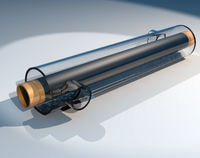
Photo from wikipedia
Abstract As a simple and efficient heat transfer device, the pulsating heat pipe (PHP) has been considered as one of the most effective methods to meet the challenges of high… Click to show full abstract
Abstract As a simple and efficient heat transfer device, the pulsating heat pipe (PHP) has been considered as one of the most effective methods to meet the challenges of high heat flux. Current studies focused on the heat transfer performance of the PHP with a small diameter (d ≤ 3 mm). However, the PHP with a relatively large diameter has better performance due to the larger heat capacity of the working fluid at the same filling ratio. Besides, compared with the PHP with circular channels, the PHP with rectangular channels has special advantages due to the unique structures. On the basis of this, an experimental setup of the PHP with rectangular channels of 4 mm equivalent inner diameter was built, and the influence of cross-section shape on the start-up characteristics and heat transfer performance of the PHP was investigated. The experimental results showed that the start-up process shifted from a “sudden start-up mode” to a “smooth start-up mode” with the increase of heating power. The start-up heating power of the PHP with rectangular channels was (1.5–2) times greater as the heating power of the PHP with circular channels. Furthermore, the thermal resistance of the PHP with rectangular channels was only (30–40)% of the PHP with circular channels, and the temperature differences between the evaporation section and the condensation section were (10–20) °C lower than those of the PHP with circular channels under the same filling ratio and heat flux. It could also be concluded from the results that the lowest thermal resistance was achieved when filling ratio was 0.3 within the range of experimental data. The experimental results will provide valuable references for the optimal design of the PHP and further studies.
Journal Title: Applied Thermal Engineering
Year Published: 2017
Link to full text (if available)
Share on Social Media: Sign Up to like & get
recommendations!